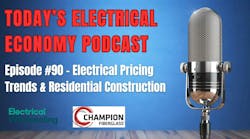A growing economy, rising household formations, low mortgage rates and pent-up demand will help single-family housing production to rev up in 2015 while a growth in renters will keep the multi-family market at cruising altitude or higher, according to economists who participated in the recent National Association of Home Builders (NAHB) 2014 Fall Construction Forecast Webinar.
“Single-family builders are feeling good. They are not overly confident, but confident enough to keep moving forward,” NAHB Chief Economist David Crowe said in a press release about the webinar.
He added that the single-family sector will finish out the year much stronger than it began and set the stage for a robust 2015 for the housing market. “This is mostly due to significant pent-up demand and steady job and economic growth that will allow trade-up buyers who have delayed home purchases due to job insecurity to enter the marketplace,” he said.
NAHB is forecasting 991,000 total housing starts in 2014, up 6.6% from 930,000 units last year. Single-family production is expected to rise 2.5% this year to 637,000 units, increase an additional 26% next year to 802,000 and reach 1.1 million in 2016. Setting the 2000-2003 period as a benchmark for normal housing activity when single-family production averaged 1.3 million units annually, single-family starts are expected to steadily rise from 48% of what is considered a typical market in the third quarter of 2014 to 90% of normal by the fourth quarter of 2016. Multi-family starts, which Crowe said are now at a normal level of production, are projected to increase 15% in 2014 to 356,000 units and hold steady next year.
Taking an even more bullish outlook, Mark Zandi, chief economist at Moody’s Analytics, said prospects are good for continued gains in overall economic and housing activity. “The reason is that job growth is quite strong,” Zandi said during the webinar. “Currently, we are creating about 225,000 jobs per month, or 2.75 million per year. That is double the pace necessary to reduce unemployment and under-employment, which augers very, very well for housing demand and the housing market more broadly.”
With the current supply of housing running just over 1 million units on annualized basis, Zandi said this figure is well below what is needed for the longer run. In the aftermath of the Great Recession, new household formations were depressed as the number of Millennials living with their parents or doubling or tripling up in apartments soared to about 3 million to 4 million above normal, according to Zandi. As the economy continues to improve and these 18-to-34 year-olds begin to form their own households, this will boost overall demand for new housing construction.
“In a normal year, there should be demand for 1.7 million units,” he said, adding that each single-family home generates about 3.5 jobs over the course of a year and every multi-family unit produces 1.5 jobs over the same period. Taking this one step further, Zandi said increasing the housing stock by 700,000 units to meet this unmet demand would create 2.1 million jobs, which “would reduce unemployment by 1.5 percentage points.”
By the end of 2017, Zandi expects mortgage rates to rise from their current rate of about 4% back to their “equilibrium” of 6%, which he noted would be very consistent with a solid job market and solid housing market. “The housing market will be fine because of better employment, higher wages and solid economic growth, which will trump the effect of higher mortgage rates,” he said. He added that single-family starts could be closing in on 1 million units by the end of 2015 and multi-family production could go as high as 500,000 units.
Delving beneath the national numbers, Robert Denk, NAHB’s assistant vice president for forecasting and analysis, noted the housing recovery will vary by state and region. “We are getting back to the point where economic conditions are dictating the strength of local housing markets,” said Denk. “It’s very clear that those states with higher levels of payroll employment or labor market recovery are associated with healthier housing markets.”
NAHB said energy-producing states — North Dakota, Texas, Louisiana, Montana and Wyoming — where job growth is strong are also at the forefront of the housing recovery while Iowa and other farm belt states supported by agricultural commodities are also running above the nationwide average. Meanwhile, states such as Nevada, Arizona, New Mexico, Alabama, Rhode Island and New Jersey that are coping with weak labor markets are also struggling to get their housing activity back on track.
Housing nationwide bottomed out at an average of 27% of normal production in early 2009 and the gradual and steady housing recovery now underway across the land will bring nationwide single-family housing starts to 68% of normal by the fourth quarter of 2015 and 90% of normal by the end of 2016. In another way of looking at the long road back to normal, by the end of 2016 the top 40% of states will be back to normal production levels, compared to the bottom 20%, which will still be below 75%.
Texas is home to several of the fastest-growing markets for both single-family and multi-family construction. U.S. Census data for year-to-date building permits through Sept. 2014 showed builders in the Lone Star state had pulled thousands of building permits in Houston (29,600), the leading market, Dallas (19,780), and Austin (9,002) MSAs. These three cities are among the U.S. leaders in single-family permits, and Dallas (13,450) and Houston (18,880) were ranked among the three largest MSAs for multi-family permits. New York led all MSAs with 27,880 permits for buildings with five or more units. Los Angeles (12,390) and Washington, D.C. (10,140) were also in the top five multi-family MSAs.








